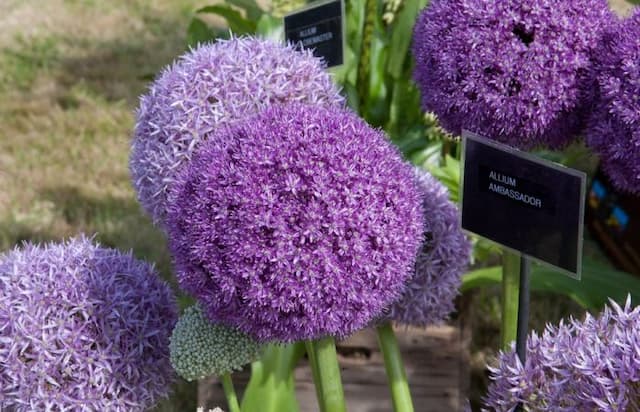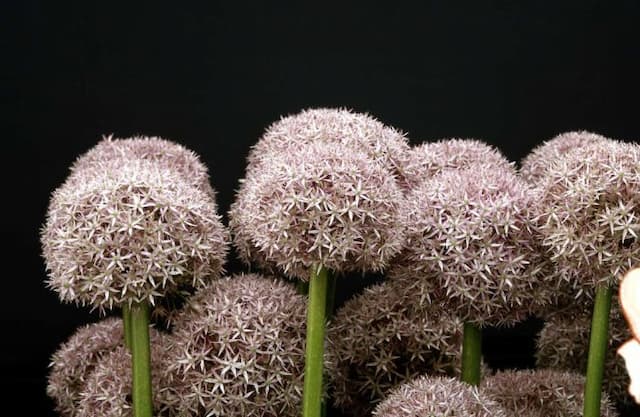Rosy garlic Allium roseum











ABOUT
Allium roseum, known commonly as rosy garlic, is a plant characterized by its charming flowers and foliage. The plant typically displays a cluster of star-shaped flowers that are pale pink to rose in color, often exhibiting a gentle gradient of hues. These delicate-looking flowers form a rounded cluster at the top of a slender, leafless stalk, creating an umbel-like inflorescence that is visually appealing in gardens and natural settings. The foliage of rosy garlic consists of long, narrow, and linear leaves which are a rich green in color. These leaves grow from the base of the plant and in some cases may have a slightly bluish or glaucous tinge. Each individual flower within the cluster comprises six tepals – the term used for petals and sepals that look similar – which spread outward and sometimes feature a darker midvein that adds depth to their coloration. The reproductive parts such as the stamens and pistil are generally visible in the center of the flowers, contributing to their ornamental look. The overall appearance of rosy garlic is somewhat airy and delicate, which can add a touch of grace to the environment where it grows. Its rosy blooms provide a soft splash of color, making it a favored choice for gardens, borders, and naturalistic settings.
About this plant
 Names
NamesSynonyms
Rosy Garlic, Mediterranean Garlic
Common names
Allium roseum var. bulbilliferum, Allium roseum var. odoratissimum, Allium roseum var. roseum, Nectaroscordum roseum.
 Toxicity
ToxicityTo humans
Rosy garlic (Allium roseum) is not generally considered toxic to humans if consumed in typical food quantities. However, as with many Allium species, it should be consumed in moderation. While it can be used similarly to culinary garlic or onions, overconsumption may cause gastrointestinal irritation or discomfort due to the presence of various sulfur compounds. These compounds, although not significantly toxic, can lead to symptoms like nausea, vomiting, or diarrhea if large amounts of the plant are ingested. In people with a sensitivity to Allium species, even normal culinary amounts may trigger allergic reactions. It's also worth noting that excessive consumption of Allium species might have anticoagulant effects due to their high content of organosulfur compounds. To pets: Rosy garlic (Allium roseum) is toxic to pets, especially cats and dogs. Plants in the Allium family contain compounds that can be harmful to animals if ingested. The ingestion of rosy garlic can lead to hemolysis, which is the destruction of red blood cells. Symptoms of rosy garlic poisoning may include vomiting, diarrhea, stomach pain, lethargy, elevated heart and respiratory rates, weakness, and exercise intolerance. In severe cases, it can cause jaundice, anemia, or even death. If you suspect your pet has ingested rosy garlic, it is crucial to seek veterinary care immediately.
To pets
To humans: Rosy garlic (Allium roseum) is not generally considered toxic to humans if consumed in typical food quantities. However, as with many Allium species, it should be consumed in moderation. While it can be used similarly to culinary garlic or onions, overconsumption may cause gastrointestinal irritation or discomfort due to the presence of various sulfur compounds. These compounds, although not significantly toxic, can lead to symptoms like nausea, vomiting, or diarrhea if large amounts of the plant are ingested. In people with a sensitivity to Allium species, even normal culinary amounts may trigger allergic reactions. It's also worth noting that excessive consumption of Allium species might have anticoagulant effects due to their high content of organosulfur compounds. Rosy garlic (Allium roseum) is toxic to pets, especially cats and dogs. Plants in the Allium family contain compounds that can be harmful to animals if ingested. The ingestion of rosy garlic can lead to hemolysis, which is the destruction of red blood cells. Symptoms of rosy garlic poisoning may include vomiting, diarrhea, stomach pain, lethargy, elevated heart and respiratory rates, weakness, and exercise intolerance. In severe cases, it can cause jaundice, anemia, or even death. If you suspect your pet has ingested rosy garlic, it is crucial to seek veterinary care immediately.
 Characteristics
CharacteristicsLife cycle
Perennials
Foliage type
Deciduous
Color of leaves
Green
Flower color
Pink
Height
1 feet 6 inches (45 cm)
Spread
0 feet 6 inches (15 cm)
Plant type
Bulb
Hardiness zones
7
Native area
Mediterranean
Benefits
 General Benefits
General Benefits- Edible parts: Allium roseum, commonly known as rosy garlic, has edible leaves and bulbs that can be used in cooking, imparting a mild garlic flavour to dishes.
- Culinary uses: The flowers and bulbs of rosy garlic can be used to make vinegars and oils more aromatic, and its leaves can be chopped into salads or cooked.
- Garden aesthetics: With its delicate pink flowers, rosy garlic adds a touch of color and beauty to gardens and can be used in ornamental borders or wildflower meadows.
- Attracts pollinators: The blooming flowers of Allium roseum are known to attract bees, butterflies, and other beneficial pollinators, supporting the local ecosystem.
- Low maintenance: Rosy garlic is a hardy plant that requires minimal care once established, making it suitable for gardeners of all skill levels.
- Drought resistance: This plant is quite resistant to drought, which can be particularly beneficial in areas with low rainfall or for water-wise gardening practices.
- Culinary tradition: In certain Mediterranean cuisines, the use of Allium roseum is rooted in traditional cooking practices, enriching cultural heritage through its use in recipes.
- Companion planting: Rosy garlic can be used in companion planting to help deter pests from other plants without the use of chemicals.
 Medical Properties
Medical PropertiesThis plant is not used for medical purposes.
 Air-purifying Qualities
Air-purifying QualitiesThis plant is not specifically known for air purifying qualities.
 Other Uses
Other Uses- Allium roseum, commonly known as rosy garlic, can be used to create a natural dye, with different parts of the plant producing varying shades on textiles.
- The bulbs of rosy garlic can act as a repellent for moles and voles when planted in gardens or around crops.
- Rosy garlic can be planted for ornamental purposes due to its attractive flowers, which can add aesthetic value to gardens and landscapes.
- The dried flowers of rosy garlic can be incorporated into potpourri mixes for their subtle fragrance and decorative appeal.
- This plant can play a role in companion planting, as it can help to deter aphids and other pests from more susceptible plants nearby.
- Rosy garlic can be used as a natural fertilizer when its leaves and stems are composted and added to soil to enrich it with nutrients.
- In some cultures, rosy garlic is used ceremonially or symbolically, such as in floral arrangements for certain festivities or traditions.
- The plant contributes to soil health by storing sulfur, which is known to have natural fungicidal properties, benefiting nearby plants.
- The strong aroma of rosy garlic can be harnessed to mask less pleasant odors in outdoor settings, such as near compost heaps or animal pens.
- Farmers may plant rosy garlic as a boundary or barrier crop to delineate sections within fields or to reduce soil erosion along the edges of agricultural land.
Interesting Facts
 Feng Shui
Feng ShuiThe Rosy Garlic is not used in Feng Shui practice.
 Zodiac Sign Compitability
Zodiac Sign CompitabilityThe Rosy Garlic is not used in astrology practice.
 Plant Symbolism
Plant Symbolism- Unity: The structure of the Rosy Garlic's round, globe-like clusters represents unity and togetherness.
- Patience: As a plant that takes time to bloom, Rosy Garlic is symbolic of patience and the anticipation of something beautiful.
- Protection: Alliums are known for their ability to repel unwanted animals and pests, translating into a symbol of safeguarding against harm.
- Humility: Despite its beautiful and striking flowers, Rosy Garlic maintains a simplicity that can be attributed to modesty.
- Good Fortune: In some cultures, it is believed that alliums like Rosy Garlic can bring luck and prosperity.
 Water
WaterRosy garlic should be watered moderately, ensuring the soil is moist but not waterlogged. During the growing season in spring and summer, water it approximately every 7 to 10 days with around 1 gallon of water per square yard of soil, adjusting for rainfall. Less frequent watering is needed when the plant is dormant in winter. Over-watering can lead to bulb rot, so it is crucial to let the soil dry out somewhat between waterings.
 Light
LightRosy garlic thrives in full sunlight to light shade. The best spot for this plant is an area where it can receive at least six hours of direct sunlight daily. If grown indoors, a south-facing window is ideal to provide the bright light conditions it prefers.
 Temperature
TemperatureRosy garlic prefers moderate temperatures and is hardy in a range between 28°F and 75°F. It can survive brief dips in temperature as low as 20°F but prefers the ideal growing temperature to be between 50°F and 70°F.
 Pruning
PruningPruning rosy garlic is generally not needed as the plant naturally dies back after flowering. However, you can remove spent flower stalks to tidy the plant and promote better bulb growth. The best time for pruning is after the flowers have faded and the foliage has begun to yellow, usually in late spring or early summer.
 Cleaning
CleaningAs needed
 Soil
SoilRosy Garlic thrives in a well-drained soil mixture, ideally enriched with organic matter such as compost. A good mix might consist of two parts loam, one part sand or perlite, and one part compost for nutrient balance. The ideal soil pH for Rosy Garlic is slightly acidic to neutral, ranging from 6.0 to 7.0.
 Repotting
RepottingRosy Garlic should be repotted every 2 to 3 years as it can become pot-bound and to refresh the soil. The best time to repot is during the dormant season, in autumn, after the leaves have yellowed and died back.
 Humidity & Misting
Humidity & MistingRosy Garlic prefers dry to average humidity levels and does not require any special humidity adjustments. It is well-suited to typical indoor humidity conditions.
 Suitable locations
Suitable locationsIndoor
Place Rosy Garlic near a sunny window for ample light.
Outdoor
Plant Rosy Garlic in full sun to partial shade.
Hardiness zone
7-9 USDA
 Life cycle
Life cycleAllium roseum, commonly known as rosy garlic, starts its life cycle when a seed germinates in warm moist soil, typically in spring. The sprout emerges, developing into a green shoot with long, slender leaves. The plant undergoes vegetative growth, forming a bulb that stores energy for the next stage. Flower stalks, or scapes, appear in late spring to early summer, leading to the flowering stage where clusters of pink to rose-colored flowers bloom. Afterward, the plant sets seed, which disperses to create new plants, and the foliage dies back as the plant enters dormancy. The bulb overwinters, remaining dormant until the following spring when the cycle resumes.
 Propogation
PropogationPropogation time
Spring
The most popular method of propagation for Allium roseum, commonly known as rosy garlic, is by dividing the cloves from the main bulb. This is generally done in the fall after the foliage has died back. Gardeners carefully dig up the bulbs and gently separate the individual cloves, which are then immediately replanted about 3 inches deep and 6 to 8 inches apart. The newly planted cloves will then root and establish themselves throughout the winter, producing new shoots in the spring. By using this form of vegetative propagation, the plant's characteristics are maintained, and the grower can quickly expand their rosy garlic collection.









